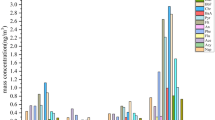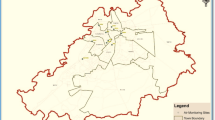Abstract
Exposure to diesel engine exhaust (DEE) was associated with various adverse health effects including lung cancer. Particle size distribution and profiles of organic compounds in both particle and gas phases of DEE that could provide valuable insights into related health effects were measured in a diesel engine testing workshop. Concentrations of urinary 6 mono-hydroxylated polycyclic aromatic hydrocarbons (OH-PAHs) in 137 DEE-exposed workers and 127 non-DEE-exposed workers were determined. Benchmark dose method was applied to estimate lower limit of benchmark dose (BMDL) of urinary OH-PAHs most specific to DEE exposure for previously reported cancer biomarkers. We found that 84.3% of diesel exhaust particles were ultrafine particles. Indeno[123-cd]pyrene and phenanthrene were the most abundant carcinogenic and noncarcinogenic PAHs in the particle phase of DEE, respectively. Principal component analysis demonstrated that urinary hydroxyphenanthrene (OHPhe) had highest loading value on principal component (PC) representative of DEE exposure and lowest loading value on PC representative of smoking status. BMDLs of urinary OHPhe from best-fitting models for cancer biomarkers including micronucleus and 1,N6-ethenodeoxyadenosine were 1.08 μg/g creatinine and 2.82 μg/g creatinine, respectively. These results provided basis for understanding DEE exposure induced health effects and potential threshold for regulating DEE levels in an occupational setting.
This is a preview of subscription content, access via your institution
Access options
Subscribe to this journal
Receive 6 print issues and online access
$259.00 per year
only $43.17 per issue
Buy this article
- Purchase on Springer Link
- Instant access to full article PDF
Prices may be subject to local taxes which are calculated during checkout




Similar content being viewed by others
References
Hart JE, Laden F, Schenker MB, Garshick E. Chronic obstructive pulmonary disease mortality in diesel-exposed railroad workers. Environ Health Perspect. 2006;114:1013–7.
Puett RC, Hart JE, Yanosky JD, Paciorek C, Schwartz J, Suh H, et al. Chronic fine and coarse particulate exposure, mortality, and coronary heart disease in the Nurses’ Health Study. Environ Health Perspect. 2009;117:1697–701.
Benbrahim-Tallaa L, Baan RA, Grosse Y, Lauby-Secretan B, El Ghissassi F, Bouvard V, et al. Carcinogenicity of diesel-engine and gasoline-engine exhausts and some nitroarenes. Lancet Oncol. 2012;13:663–4.
Wichmann HE. Diesel exhaust particles. Inhal Toxicol. 2007;19(Suppl 1):241–4.
Li XY, Brown D, Smith S, MacNee W, Donaldson K. Short-term inflammatory responses following intratracheal instillation of fine and ultrafine carbon black in rats. Inhal Toxicol. 1999;11:709–31.
Cho SH, Tong H, McGee JK, Baldauf RW, Krantz QT, Gilmour MI. Comparative toxicity of size-fractionated airborne particulate matter collected at different distances from an urban highway. Environ Health Perspect. 2009;117:1682–9.
Hiura TS, Kaszubowski MP, Li N, Nel AE. Chemicals in diesel exhaust particles generate reactive oxygen radicals and induce apoptosis in macrophages. J Immunol. 1999;163:5582–91.
Bostrom CE, Gerde P, Hanberg A, Jernstrom B, Johansson C, Kyrklund T, et al. Cancer risk assessment, indicators, and guidelines for polycyclic aromatic hydrocarbons in the ambient air. Environ Health Perspect. 2002;110(Suppl 3):451–88.
Haber LT, Allen BC, Kimmel CA. Non-cancer risk assessment for nickel compounds: issues associated with dose–response modeling of inhalation and oral exposures. Toxicol Sci. 1998;43:213–29.
Stewart PA, Coble JB, Vermeulen R, Schleiff P, Blair A, Lubin J, et al. The diesel exhaust in miners study: I. Overview of the exposure assessment process. Ann Occup Hyg. 2010;54:728–46.
Zhang X, Duan H, Gao F, Li Y, Huang C, Niu Y, et al. Increased micronucleus, nucleoplasmic bridge, and nuclear bud frequencies in the peripheral blood lymphocytes of diesel engine exhaust-exposed workers. Toxicol Sci. 2015;143:408–17.
Shen M, Bin P, Li H, Zhang X, Sun X, Duan H, et al. Increased levels of etheno-DNA adducts and genotoxicity biomarkers of long-term exposure to pure diesel engine exhaust. Sci Total Environ. 2016;543:267–73.
Zhang X, Li J, He Z, Duan H, Gao W, Wang H, et al. Associations between DNA methylation in DNA damage response-related genes and cytokinesis-block micronucleus cytome index in diesel engine exhaust-exposed workers. Arch Toxicol. 2016;90:1997–2008.
Duan H, Jia X, Zhai Q, Ma L, Wang S, Huang C, et al. Long-term exposure to diesel engine exhaust induces primary DNA damage: a population-based study. Occup Environ Med. 2016;73:83–90.
Fenech M. The in vitro micronucleus technique. Mutat Res. 2000;455:81–95.
Bonassi S, Znaor A, Ceppi M, Lando C, Chang WP, Holland N, et al. An increased micronucleus frequency in peripheral blood lymphocytes predicts the risk of cancer in humans. Carcinogenesis. 2007;28:625–31.
Collins AR. The comet assay for DNA damage and repair: principles, applications, and limitations. Mol Biotechnol. 2004;26:249–61.
Chung FL, Chen HJ, Nath RG. Lipid peroxidation as a potential endogenous source for the formation of exocyclic DNA adducts. Carcinogenesis. 1996;17:2105–11.
Teodoridis JM, Hall J, Marsh S, Kannall HD, Smyth C, Curto J, et al. CpG island methylation of DNA damage response genes in advanced ovarian cancer. Cancer Res. 2005;65:8961–7.
Zhang LP, Zhang X, Duan HW, Meng T, Niu Y, Huang CF, et al. Long-term exposure to diesel engine exhaust induced lung function decline in a cross sectional study. Ind Health. 2017;55:13–26.
Birch ME. Occupational monitoring of particulate diesel exhaust by NIOSH method 5040. Appl Occup Environ Hyg. 2002;17:400–5.
OSHA. Coal tar pitch volatiles (CTPV), coke oven emissions (COE), and selected polynuclear aromatic hydrocarbons (PAHs). In: OSHA sampling & analytical methods (OSHA). Salt Lake City,UT: 1986.
He Z, Li D, Ma J, Chen L, Duan H, Zhang B, et al. TRIM36 hypermethylation is involved in polycyclic aromatic hydrocarbons-induced cell transformation. Environ Pollut.; Elsevier 2017;225:93–103.
Abadi H, Edelman B, Valentin D, Dowling WJ. Experimental design and analysis for psychology. Oxford, UK: Oxford University Press; 2009.
Zhang Y, Tao S, Shen H, Ma J. Inhalation exposure to ambient polycyclic aromatic hydrocarbons and lung cancer risk of Chinese population. Proc Natl Acad Sci USA. 2009;106:21063–7.
Zhang L, Chen R, Lv J. Spatial and seasonal variations of polycyclic aromatic hydrocarbons (PAHs) in ambient particulate matter (PM10, PM2.5) in three mega-cities in China and identification of major contributing source types. Bull Environ Contam Toxicol. 2016;96:827–32.
Grose M, Sakurai H, Savstrom J, Stolzenburg MR, Watts WF Jr, et al. Chemical and physical properties of ultrafine diesel exhaust particles sampled downstream of a catalytic trap. Environ Sci Technol. 2006;40:5502–7.
Oberdorster G, Sharp Z, Atudorei V, Elder A, Gelein R, Kreyling W, et al. Translocation of inhaled ultrafine particles to the brain. Inhal Toxicol. 2004;16:437–45.
Levesque S, Surace MJ, McDonald J, Block ML. Air pollution & the brain: Subchronic diesel exhaust exposure causes neuroinflammation and elevates early markers of neurodegenerative disease. J Neuroinflamm. 2011;8:105.
Lynn M, Hildemann GRM, Glen R. Chemical composition of emissions from urban sources of fine organic aerosol. Environ Sci Technol. 1991;25:744–59. Cass
Tsai JH, Chen SJ, Huang KL, Lee WJ, Kuo WC, Lin WY. Characteristics of particulate emissions from a diesel generator fueled with varying blends of biodiesel and fossil diesel. J Environ Sci Health A Tox Hazard Subst Environ Eng. 2011;46:204–13.
Shah SD, Cocker DR 3rd, Miller JW, Norbeck JM. Emission rates of particulate matter and elemental and organic carbon from in-use diesel engines. Environ Sci Technol. 2004;38:2544–50.
Watson JG, Chow JC, Lu Z, Fujita EM, Lowenthal DH, Lawson DR. et al. chemical mass balance source apportionment of PM10 during the Southern California air quality study. Aerosol Sci Technol. 1994;21:1–36.
Zielinska B, McDonald JD, Hayes T, Chow JC, Fujita EM, Watson JG. Northern front range air quality study. In: Source measurements, Vol. B Prepared for Colorado State University, Fort Collins, CO, by Desert Research Institute, Reno, NV; 1998.
Kuusimaki L, Peltonen K, Mutanen P, Savela K. Analysis of particle and vapour phase PAHs from the personal air samples of bus garage workers exposed to diesel exhaust. Ann Occup Hyg. 2003;47:389–98.
Lv Y, Li X, Xu T, Cheng T, Yang X, Chen J, et al. Size distributions of polycyclic aromatic hydrocarbons in urban atmosphere: sorption mechanism and source contributions to respiratory deposition. Atmos Chem Phys. 2016;16:2971–83.
WHO. Benzene. In: Air quality guidelines for Europe, 2nd ed. Copenhagen: World Health Organization Regional Office for Europe; 2000.
Hansen AM, Wallin H, Binderup ML, Dybdahl M, Autrup H, Loft S, et al. Urinary 1-hydroxypyrene and mutagenicity in bus drivers and mail carriers exposed to urban air pollution in Denmark. Mutat Res. 2004;557:7–17.
Wild CP. Complementing the genome with an “exposome”: the outstanding challenge of environmental exposure measurement in molecular epidemiology. Cancer Epidemiol Biomark Prev. 2005;14:1847–50.
Jacob J, Grimmer G, Dettbarn G. Profile of urinary phenanthrene metabolites in smokers and non-smokers. Biomarkers. 1999;4:319–27.
MSHA. Diesel Particulate Matter Exposure of Underground Metal and Nonmetal Miners, Final Rule. 30 CFR Part 57.5060 U.S. Mine Safety and Health Administration; 2001.
ACGIH. American Conference of Environmental Industrial Hygienists. Diesel Exhaust (Particulate and Particulate Adsorbed Components), Draft TLV-TWA Document. Cincinnati: ACGIH; 2001.
Kuang D, Zhang W, Deng Q, Zhang X, Huang K, Guan L, et al. Dose–response relationships of polycyclic aromatic hydrocarbons exposure and oxidative damage to DNA and lipid in coke oven workers. Environ Sci Technol. 2013;47:7446–56.
Li Z, Sandau CD, Romanoff LC, Caudill SP, Sjodin A, Needham LL, et al. Concentration and profile of 22 urinary polycyclic aromatic hydrocarbon metabolites in the US population. Environ Res. 2008;107:320–31.
von Stackelberg K, Buonocore J, Bhave PV, Schwartz JA. Public health impacts of secondary particulate formation from aromatic hydrocarbons in gasoline. Environ Health. 2013;12:19.
Acknowledgements
This study was supported by the National Natural Science Foundation of China (81130050, 91643203, and 91543208). We thank the members of Henan Institute of Occupational Medicine (Zhengzhou, China) for assistance with sample collection and instrumental support.
Author information
Authors and Affiliations
Corresponding author
Ethics declarations
Conflict of interest
The authors declare that they have no conflict of interest.
Electronic supplementary material
Rights and permissions
About this article
Cite this article
Niu, Y., Zhang, X., Meng, T. et al. Exposure characterization and estimation of benchmark dose for cancer biomarkers in an occupational cohort of diesel engine testers. J Expo Sci Environ Epidemiol 28, 579–588 (2018). https://doi.org/10.1038/s41370-018-0061-x
Received:
Revised:
Accepted:
Published:
Issue Date:
DOI: https://doi.org/10.1038/s41370-018-0061-x
Keywords
This article is cited by
-
Circulatory metabolites trigger ex vivo arterial endothelial cell dysfunction in population chronically exposed to diesel exhaust
Particle and Fibre Toxicology (2022)
-
Chronic exposure to diesel exhaust may cause small airway wall thickening without lumen narrowing: a quantitative computerized tomography study in Chinese diesel engine testers
Particle and Fibre Toxicology (2021)
-
Critical Review of Diesel Exhaust Exposure Health Impact Research Relevant to Occupational Settings: Are We Controlling the Wrong Pollutants?
Exposure and Health (2021)
-
Carbon content in airway macrophages and genomic instability in Chinese carbon black packers
Archives of Toxicology (2020)



